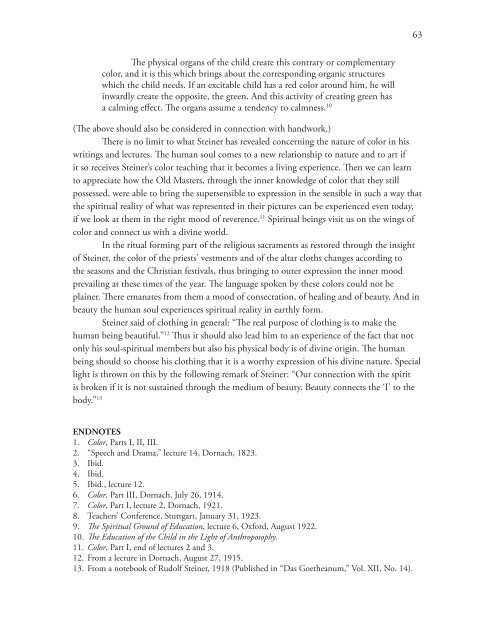Handwork and Handicrafts - Waldorf Research Institute
Handwork and Handicrafts - Waldorf Research Institute
Handwork and Handicrafts - Waldorf Research Institute
You also want an ePaper? Increase the reach of your titles
YUMPU automatically turns print PDFs into web optimized ePapers that Google loves.
63<br />
The physical organs of the child create this contrary or complementary<br />
color, <strong>and</strong> it is this which brings about the corresponding organic structures<br />
which the child needs. If an excitable child has a red color around him, he will<br />
inwardly create the opposite, the green. And this activity of creating green has<br />
a calming effect. The organs assume a tendency to calmness. 10<br />
(The above should also be considered in connection with h<strong>and</strong>work.)<br />
There is no limit to what Steiner has revealed concerning the nature of color in his<br />
writings <strong>and</strong> lectures. The human soul comes to a new relationship to nature <strong>and</strong> to art if<br />
it so receives Steiner’s color teaching that it becomes a living experience. Then we can learn<br />
to appreciate how the Old Masters, through the inner knowledge of color that they still<br />
possessed, were able to bring the supersensible to expression in the sensible in such a way that<br />
the spiritual reality of what was represented in their pictures can be experienced even today,<br />
if we look at them in the right mood of reverence. 11 Spiritual beings visit us on the wings of<br />
color <strong>and</strong> connect us with a divine world.<br />
In the ritual forming part of the religious sacraments as restored through the insight<br />
of Steiner, the color of the priests’ vestments <strong>and</strong> of the altar cloths changes according to<br />
the seasons <strong>and</strong> the Christian festivals, thus bringing to outer expression the inner mood<br />
prevailing at these times of the year. The language spoken by these colors could not be<br />
plainer. There emanates from them a mood of consecration, of healing <strong>and</strong> of beauty. And in<br />
beauty the human soul experiences spiritual reality in earthly form.<br />
Steiner said of clothing in general: “The real purpose of clothing is to make the<br />
human being beautiful.” 12 Thus it should also lead him to an experience of the fact that not<br />
only his soul-spiritual members but also his physical body is of divine origin. The human<br />
being should so choose his clothing that it is a worthy expression of his divine nature. Special<br />
light is thrown on this by the following remark of Steiner: “Our connection with the spirit<br />
is broken if it is not sustained through the medium of beauty. Beauty connects the ‘I’ to the<br />
body.” 13<br />
ENDNOTES<br />
1. Color, Parts I, II, III.<br />
2. “Speech <strong>and</strong> Drama,” lecture 14, Dornach, 1823.<br />
3. Ibid.<br />
4. Ibid.<br />
5. Ibid., lecture 12.<br />
6. Color, Part III, Dornach, July 26, 1914.<br />
7. Color, Part I, lecture 2, Dornach, 1921.<br />
8. Teachers’ Conference, Stuttgart, January 31, 1923.<br />
9. The Spiritual Ground of Education, lecture 6, Oxford, August 1922.<br />
10. The Education of the Child in the Light of Anthroposophy.<br />
11. Color, Part I, end of lectures 2 <strong>and</strong> 3.<br />
12. From a lecture in Dornach, August 27, 1915.<br />
13. From a notebook of Rudolf Steiner, 1918 (Published in “Das Goetheanum,” Vol. XII, No. 14).

















